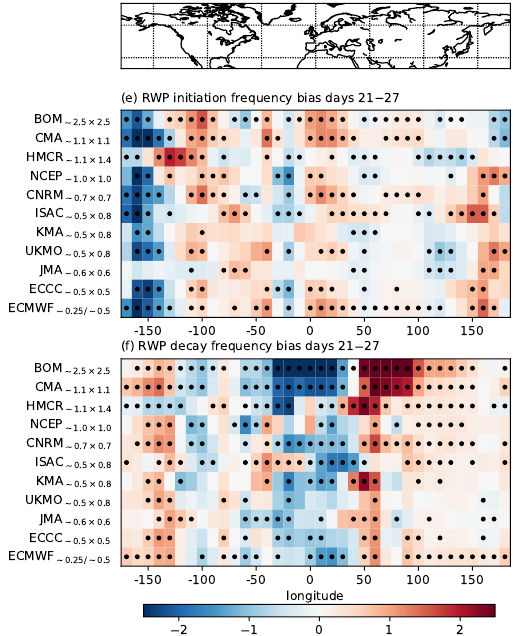Forecasts of Rossby wave packets and blocking on subseasonal timescales
Equatorward and poleward wind perturbations propagating eastward along the fast flowing air currents in midlatitudes are commonly referred to as Rossby wave packets (RWPs). Typically, the waves form in the entrance region of the midlatitude storm tracks, that is, over the western North Pacific and the western North Atlantic. Regions of RWP decay are the exit regions of the storm tracks over North America and the East Atlantic/European region. The occurrence of RWPs has been linked to extreme weather events such as intense winter storms, heat waves, and heavy precipitation. Hence, an adequate representation of RWPs in state‐of‐the‐art numerical weather prediction models is desirable to better predict these weather extremes. In a recent study [1], we now verify for the first time the representation of RWPs in a set of 11 numerical weather prediction models on time‐scales of up to 28 days. It is shown that fundamental properties such as their climatological frequency of occurrence, their life time, and their mean propagation distance are represented reasonably well. However, models ‐ especially those with a rather coarse horizontal grid spacing ‐ struggle to adequately represent the frequency of decay of these waves in the exit region of the storm tracks over the Atlantic/European sector. Instead of decaying over the eastern North Atlantic, RWPs propagate into far eastern Europe likely due to an underestimation of the occurrence frequency of long‐lasting and stationary high pressure systems – commonly referred to as blocking highs. The observed systematic errors in the frequency of blocking highs and in the RWP decay is most pronounced but not unique to models with coarse resolution. That the observed errors are not purely resolution dependent points to the effect of the different representation of key physical processes for RWP dynamics in models of the S2S database. To pinpoint these processes with process-oriented diagnostics is one goal of the Large-scale dynamics and predictability group.
[1] Quinting, J.F., and F. Vitart, Representation of synoptic‐scale Rossby Wave Packets and Blocking in the S2S Prediction Project Database, Geophys. Res. Lett., 46. https://doi.org/10.1029/2018GL081381 (2019).
[Working group: Large-scale Dynamics and Predictability]
Author: Julian Quinting
16.01.2019

